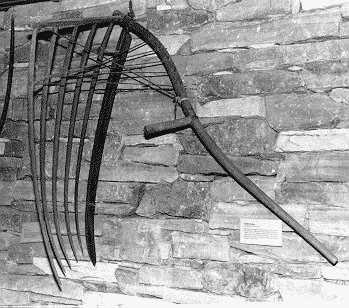
| Site Index | Subscription Info |

| Site Index | Subscription Info |
The American grain cradle consists of an arrangement of fingers attached by a light framework to the snath of a scythe. Its purpose is to gather the straw as it is cut and deposit it in a swath. At the end of the cutting stroke, the cradle is tilted to drop the straw in a pile. Using the cradle does not require stooping, as does the sickle. Also, substantially more grain can be cut in a day with the cradle. However, loss due to shattering (grain dislodged from heads due to shock) is greater with the cradle. This caused many harvesters, especially in the South, to continue using the sickle to harvest grain well into the 19th century.

A simple cradle scythe using a loop made from a twig attached to the snath, rather than wooden fingers, was described as early as the 13th century. A "scythe frame" or "scythe bow" consisting of the bow covered with wire mesh, and later, a rake-like wooden frame were used in Germany.
The American pattern cradle was developed in the late 1700's (Brewer, 1880 Census Report). It probably originated in the mid-Atlantic states, and examples are still extremely common at local Maryland and Pennsylvania farm sales. Use of the grain cradle had spread to New England by 1800. The first U.S. patent granted for a grain cradle was to Isaac Babcock, of New York state, in 1823. The cradle was used long after horse-drawn reapers and binders came into common use, especially for very small fields, and to open fields for the mechanized reaper. The last patent for a cradle is dated 1924.
A cradler can cut 2 acres of wheat per day. Experienced reapers who were proficient at wielding the cradle scythe could earn twice the daily pay of other farm laborers. the Scotch bow cradle, invented by Charles Vaughan, of Hollowell, Maine in 1837, was lighter and easier to use than previous cradles.
 A 5 finger Shaker cradle at Hancock Village, Massachusetts.
A 5 finger Shaker cradle at Hancock Village, Massachusetts.
American cradles commonly came with 3, 4, 5, or 6 fingers. In 1858, E. Whitman Co. of Baltimore advertised Grant's 5 finger cradle for $5. Sinclair & Co., of the same city, offered 5 or 6 finger cradles for $5 each. The 1897 Sears Roebuck catalog lists a 4 finger Morgan grain cradle of the "grape vine" pattern for $2.25.
The cradle scythe blade is wider than that of the grass scythe, in order to support the cut grain and allow it to slide back against the fingers. While the curve of the scythe blade is important, it is equally important that the curve of the fingers match the blade's curve. Various methods of adjusting the position of the cradle fingers were devised in the mid-19th century, since improperly adjusted fingers caused the cradle to function poorly. If the fingers do not match the blade, straws will be pulled down and not cut or will fall through or lodge in the cradle.
In order to lessen the weight of the cradle, a very light framework of wood and wire was used. Stronger cradles were used in the South, where heavy crops were harvested, and Yankee cradles did not hold up well. Several such heavy duty cradles were designed specifically to harvest hemp.
While much research has been done and volumes have been written on the development of the reaper and other mechanical harvesting machines, the importance of the simple grain cradle, especially during the first half of the 19th century, appears to have been overlooked. Even during the late 19th century, cradles were still being swung on many small farms where strong arms and backs were more abundant than cash to purchase a grain binder.
More puzzling is the fact that such a simple labor-saving device came upon the harvesting scene so late. Humans were harvesting grain with iron sickles as early as 1500 BC. Over the course of many centuries, the more modern reaping hook slowly evolved. Then, the long handled scythe and cradle finally allowed the reaper to stand erect, and also to harvest more quickly. But, even as the American cradle was being perfected, farmers were hearing of the field trials of the fascinating machines of Hussey, McCormick, Manny and others.
| graph of cradle patents by decade | graph of cradle patents by state |
| A Sampling of Cradle Patents | Table of Cradle Patents |
| other American Artifacts articles | |
© 1996, 1998, American Artifacts, Taneytown, MD.